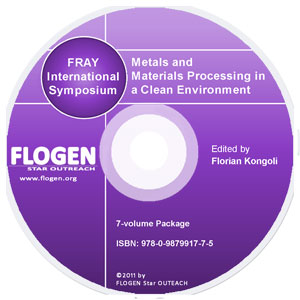
CD shopping page |
2011-Sustainable Industrial Processing Summit
|
| Editors: | Florian K |
| Publisher: | Flogen Star OUTREACH |
| Publication Year: | 2012 |
| Pages: | 764 pages |
| ISBN: | 978-0-9879917-5-1 |
| ISSN: | 2291-1227 (Metals and Materials Processing in a Clean Environment Series) |
Chemistry Of Nickel Protoxide And Acid Interaction
Maria Kalashnikova1; Leonid Volkov1; SELECT * FROM contact WHERE email_address REGEXP('mikal@nickel.spb.ru|lvv1938@yandex.ru')*********************1GIPRONICKEL INSTITUTE, St. Petersburg, Russia;
Type of Paper: Regular
Id Paper: 228
Topic: 14
Abstract:
The article offers the mechanism of nickel protoxide dissolution through its oxidation to oxide. The direct reaction of nickel protoxide dissolution by sulfuric acid:NiO + H2SO4 ® NiSO4 + H2O proceeds very slowly making practical use of this process impossible. It is known that higher nickel oxides dissolve very well; considering this fact nickel protoxide leaching through NiO oxidation to Ni2O3 with sulfuric acid use was studied.To initiate the dissolution it is necessary to supply strong oxidizing agent into the system in the amount sufficient for the creation of redox potential in the system on the level of ~1.4B. After that the oxidizer is not requires as it regenerates the oxide dissolution:2NiO + O ® Ni2O3 Ni2O3 + 2H2SO4 ® 2NiSO4 + 2H2O + OSo in the process of this kind the oxidizing agent may be required only for its mechanical loss compensation. Beside the atomic oxygen there can be used other oxidizing agents capable to provide the creation of the required redox potential, for example, S2O82-.The process indices are compared as applied to nickel protoxide synthesized from pure reagents and produced in industrial scale in the process of sulfide nickel concentrate roasting. Synthesized nickel protoxide dissolution by the acid occurs in less than a minute after the oxidizing agent is charged into the system. The oxidizing agent is used only for the process initiation in the amount not more than 1% of the stoichiometry. With this, acid consumption equals to the stoichiometric one. Industrial product dissolution lasts 2-3 hours, it requires 15-20% surplus of the acid and the oxidizing agent consumption is 8-10% of the stoichiometry, that can be explained by admixtures availability.The process is controlled and managed by the value of the redox potential in the system.